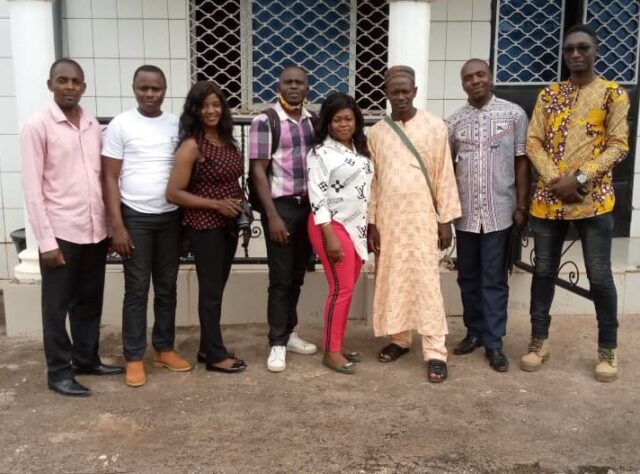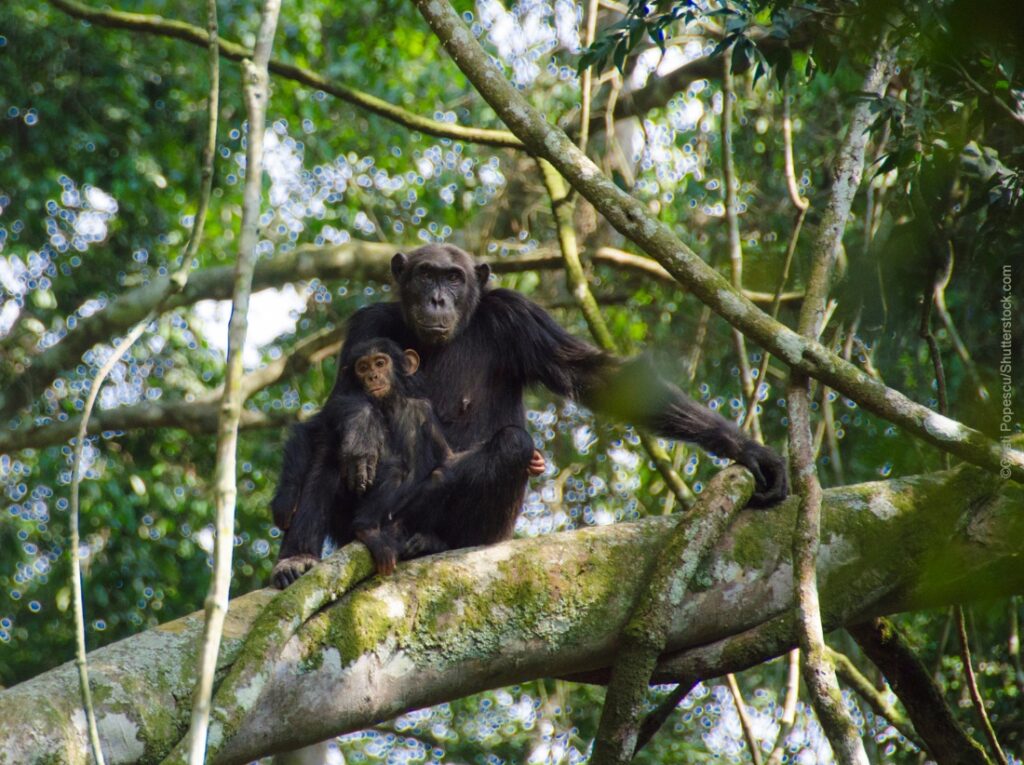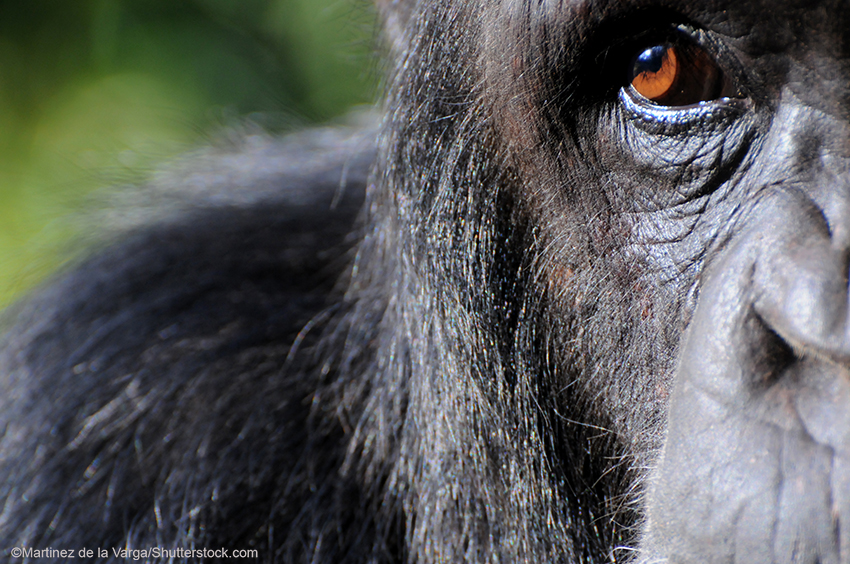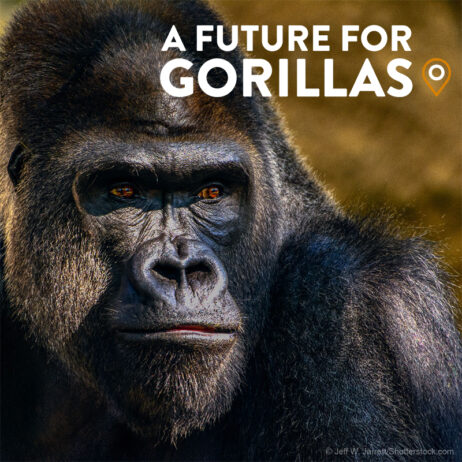
Left to right: Amos Fang Zeh, Kelvin Abang Kum, Clarise Pih, Jean Julien Ndjang Alembe, Gwendoline Angwa, Simon Hamada, Serge Abo, Ferdinand Mongo. Image credit: ERuDeF.
This month we have been asking for your support for our #FutureForGorillas appeal and today we wanted to introduce the people who are making it happen: the Cameroonians working to deliver a forest corridor, a link for threatened wildlife to travel to a safer future.
In early September, we spoke to our partner Environment and Rural Development Foundation (ERuDeF) and local people about the corridor project. What follows is the incredible story of how rangers and other members of the community were transformed after crossing paths with great apes.
“They are so, so very intelligent”
Gwendoline Angwa, Project Manager at ERuDeF
Gwendoline was trekking through the forest as part of an expedition when she sensed something – someone – was following her.
“I was the last person in the line and all of a sudden I realised a Chimpanzee was coming up just a few steps behind me. It was so amazing,” remembers Gwendoline, who is managing the project for a corridor between Cameroon’s Deng Deng National Park and the Belabo Council Forest to the south.
That Chimps and humans are fellow forest dwellers who walk the same path on this Earth has been obvious to Gwendoline in her years as a conservationist. Joined by fellow ERuDeF rangers and local people, she speaks about the clear signs of chimps’ intelligence emerging through reviewing hours of camera trap footage.
“I remember a Chimpanzee approaching the camera trap, touching and looking into the camera lens. I’m sure they were trying to learn more about the device, especially as it produces light during recording,” Gwendoline says. “There was also the case of a Chimpanzee hiding from the camera trap, using a dead leaf to cover their face. They are so, so very intelligent.”

Kelvin’s visit to a Chimpanzee reserve laid bare the sheer intellect and emotion these great apes will display to help babies in need. Image credit: Cristi Popescu/Shutterstock.com
“A baffling, problem-solving intellect”
Kelvin Abang Kum, Environmental Film Producer
To someone like Kelvin, numbers – such as the 99% of shared DNA scientists believe exist between humans and Chimpanzees – are not necessary to illustrate our bond with great apes.
The environmental film producer saw evidence of a “baffling, problem-solving intellect” as he visited a Chimpanzee reserve a few kilometres from Belabo and the proposed forest corridor.
“A mother Chimpanzee who was kept in isolation after fighting another in the reserve had to come to the rescue of her baby Chimpanzee, who was trapped in a hole while struggling to pick a banana,” Kelvin remembers. “Though in quarantine, the mother Chimpanzee was able to use a stick to help her baby out.”
“The scene was so humanlike and emotional,” Kelvin goes on to say. “The crying baby Chimpanzee showed so much sympathy in her cry for help and thanks to her mother’s bravery, to the help she had found. I thought to myself, these are humans in another form.”
“I hid and the animal did the same”
Serge Abo, Manager of community development projects at Hona Village
Serge Abo doesn’t need any convincing either of the deep connection between people and great apes. During the conversation arranged by ERuDeF, he remembers running into a Chimpanzee in the forest.
“I saw them and moved back to hide but surprisingly, the animal did the same,” Serge recounts. “After about two minutes or so, the animal tried to peep through the bush to see if I was gone but this was the same time I was peeping through, to find my way out.”
“We did this for at least three times and each time, we caught sight of each other,” Serge adds. “I wondered why and how the animal would make this gesture at the exact same time I did – surely we were calculating the seconds in the same way. Finally the animal and I decided, almost telepathically, to separate.”

The IUCN classifies Chimpanzee as ‘possibly extinct’ in Benin, Burkina Faso and Togo. Our #FutureForGorillas appeal will help safeguard the forest home of 400-600 Chimps at Deng Deng. Image credit: Martinez de la Varga/Shutterstock.com
“We stared at each other for three minutes”
Jean Julien Ndjang Alembe, Ecoguard at Deng Deng National Park
Jean Julien’s work at Deng Deng brought him up and close with a group of Chimpanzee.
“I was on my way to Lom Pangar and I caught sight of three Chimpanzees, one male and two females,” the Ecoguard explains. “I could not run because the camp was far off so I became startled with fear, I couldn’t move.”
“We stared at each other for about three minutes without anyone moving. Then suddenly, it seemed their observation session was finished, and they left. I wondered whether they would attack me but they did nothing to me,” Jean Julien adds.
Words fall short to describe our connection with the Chimpanzee. These great apes see the same deforestation we do but they can’t understand why. This month in Cameroon, there are 400-600 Chimpanzees you can do something about – a population you can safeguard by supporting our partner ERuDeF’s plan for a forest corridor.
